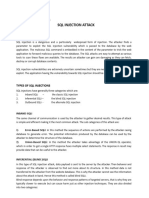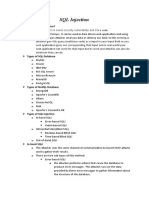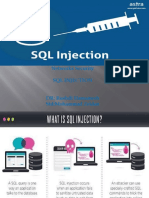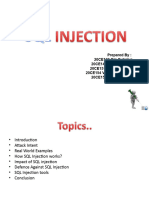0% found this document useful (0 votes)
11 views4 pagesApplied Exploit and Hacking 5
SQL Injection (SQLi) is a web application security vulnerability that allows attackers to manipulate database queries through malicious SQL code. The document outlines various types of SQLi, including Classic, Blind, and Out-of-Band SQL Injection, along with methods for prevention such as parameterized queries, input validation, and the use of web application firewalls. It emphasizes the importance of regular security testing to identify and mitigate SQLi risks.
Uploaded by
syedbadshah0550Copyright
© © All Rights Reserved
We take content rights seriously. If you suspect this is your content, claim it here.
Available Formats
Download as DOCX, PDF, TXT or read online on Scribd
0% found this document useful (0 votes)
11 views4 pagesApplied Exploit and Hacking 5
SQL Injection (SQLi) is a web application security vulnerability that allows attackers to manipulate database queries through malicious SQL code. The document outlines various types of SQLi, including Classic, Blind, and Out-of-Band SQL Injection, along with methods for prevention such as parameterized queries, input validation, and the use of web application firewalls. It emphasizes the importance of regular security testing to identify and mitigate SQLi risks.
Uploaded by
syedbadshah0550Copyright
© © All Rights Reserved
We take content rights seriously. If you suspect this is your content, claim it here.
Available Formats
Download as DOCX, PDF, TXT or read online on Scribd
/ 4



























































































